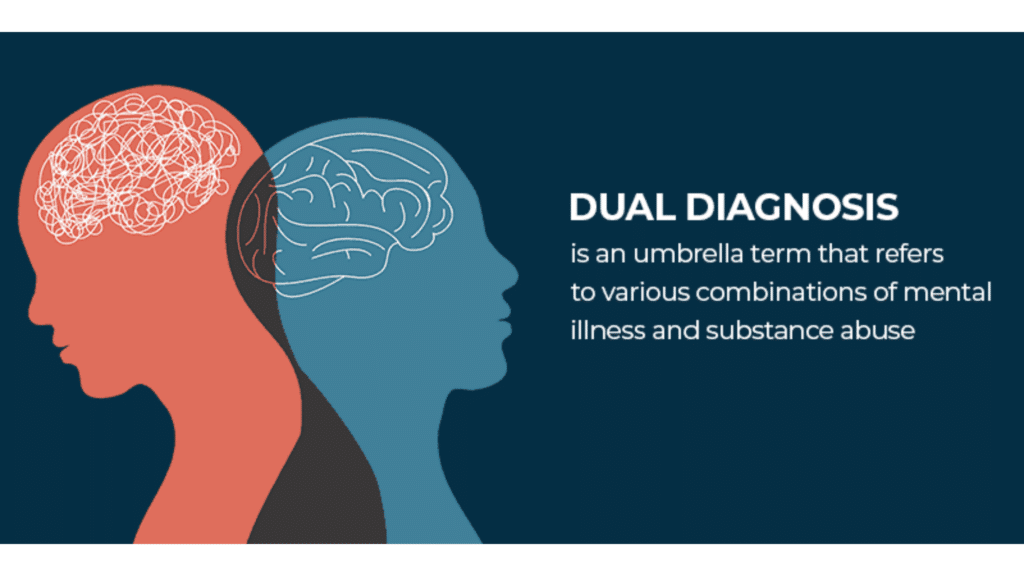Have you ever wondered how individuals facing both addiction and mental health challenges navigate their journey to recovery? The solution lies in a specialized support system known as drug rehab dual diagnosis, a critical and personalized step toward healing.
In simple terms, dual diagnosis rehab is like a tailored plan that addresses both addiction and mental health concerns simultaneously. It’s not just a treatment; it’s a comprehensive strategy that ensures a holistic and enduring recovery.
In the upcoming sections, we’ll explore the essential elements of dual diagnosis rehab. From understanding the unique situation to crafting a plan that covers all bases, and providing ongoing support even after the primary treatment, each aspect plays a crucial role in shaping a recovery journey tailored to individual needs.
Join us as we delve into the effectiveness of dual diagnosis rehab and how it stands as a professional yet accessible support system for those seeking a renewed sense of well-being in Long Island.

Dual Diagnosis: When Mental Health and Addiction Collide
Dual diagnosis, often referred to as co-occurring disorders, is a term that encapsulates the simultaneous presence of a mental health disorder and a substance use disorder in an individual. This complex interplay requires a specialized approach to treatment that addresses both conditions concurrently.
In simpler terms, dual diagnosis signifies that someone is dealing with not only issues related to substance use but also facing challenges related to their mental health. These two aspects often influence and exacerbate each other, creating a unique set of circumstances that necessitate a comprehensive and integrated strategy for effective resolution.
Understanding the Duality:
Understanding dual diagnosis involves recognizing the bidirectional relationship between substance abuse and mental health. It is not just about treating one issue or the other but acknowledging the intricate connection between the two. This recognition is crucial for developing treatment plans that holistically address the individual’s needs, fostering a more sustainable path to recovery.
Dual diagnosis isn’t a rare occurrence. In fact, research suggests that up to 50% of people with a mental health disorder also struggle with substance abuse, and vice versa. This overlap isn’t a coincidence. There are various reasons why addiction and mental health conditions often intertwine:
- Self-medicating: Individuals grappling with mental health issues may resort to substances as a way to alleviate or numb their symptoms, often leading to dependence and creating a cycle that requires careful intervention.
- Underlying causes: In some cases, shared factors such as trauma or genetic predisposition can contribute to both mental health problems and addiction. Identifying these underlying causes is crucial for developing targeted and effective treatment plans.
- Substance-induced mental health issues: The use of certain drugs has the potential to either trigger or exacerbate mental health conditions like anxiety or psychosis. This underscores the need for a nuanced understanding of how specific substances can impact mental well-being.
How Do Dual Diagnoses Develop?
Several factors contribute to the development of these dual challenges, shaping the complex landscape of mental health and addiction. Here are key aspects illuminating how dual diagnoses may develop:
1. Self-Medication: Individuals with mental health issues may turn to substances as a means of self-medication, seeking temporary relief from their symptoms. This coping mechanism, while providing momentary respite, can lead to a cycle of dependence and exacerbate both conditions
2. Underlying Causes: Shared underlying factors, such as a history of trauma, genetic predisposition, or environmental stressors, can contribute to the development of both mental health problems and substance use disorders. Identifying and addressing these root causes is crucial for comprehensive treatment.
3. Biological Factors: Neurobiological vulnerabilities can play a role in the development of dual diagnoses. Changes in brain chemistry and functioning may make individuals more susceptible to both mental health disorders and addiction.
4. Environmental Influences: Surrounding environmental factors, including social and familial dynamics, can contribute to the manifestation of dual diagnoses. Adverse environments may exacerbate existing mental health issues and increase the likelihood of substance abuse.
5. Developmental Stages: The onset of dual diagnoses can also be linked to specific life stages. Adolescence and early adulthood, marked by significant developmental changes, may be particularly vulnerable periods for the emergence of both mental health and substance use challenges.
6. Lack of Early Intervention: Without timely intervention and support, individuals facing mental health issues may resort to substances to cope with their difficulties. The absence of early intervention measures can contribute to the escalation of both conditions.
Understanding the multifaceted nature of dual diagnoses involves recognizing the interplay of these factors. By comprehending the origins, healthcare professionals can tailor interventions to address the specific needs of individuals navigating the complex terrain of co-occurring mental health and substance use challenges.
Finding the Path to Recovery:
The journey through dual diagnosis may seem daunting, but the encouraging truth is that it doesn’t have to be a lifelong struggle. Recovery is not only possible but achievable with the right approach. The key to unlocking this potential lies in integrated treatment, a method that addresses both mental health and addiction concurrently. Here’s a glimpse into the components of this comprehensive approach:
1. Individual therapy: Tailored sessions designed to delve into the root causes of both conditions, fostering a deeper understanding and developing effective coping mechanisms.
2. Group therapy: Creating a sense of support and connection by sharing experiences with others facing similar challenges, building a community that reinforces the path to recovery.
3. Medication management: Employing medications to stabilize mood, manage symptoms, and curb cravings if necessary, providing a foundation for sustained well-being.
4. Behavioral therapies: Implementing techniques such as Cognitive Behavioral Therapy (CBT) and Dialectical Behavior Therapy (DBT) to acquire healthy coping skills and navigate negative thought patterns constructively.
5. Support groups: Extending the journey beyond treatment programs, support groups offer ongoing encouragement and accountability, fostering a network that continues to uplift individuals on their path to recovery.
In embracing this holistic approach, individuals can not only overcome the challenges of dual diagnosis but also discover a route to lasting recovery, paving the way for a brighter and healthier future.
Legal Protections for Dual Diagnosis Treatment: Understanding Time Off Rights
Recognizing the complexities of dual diagnoses, legal provisions exist to safeguard individuals seeking drug rehab dual diagnosis or dual diagnosis rehab while protecting their time off needs for comprehensive treatment. Understanding these rights empowers individuals to prioritize their well-being while navigating the intertwined threads of mental health and addiction recovery.
1. Family and Medical Leave Act (FMLA): This act grants eligible employees 12 weeks of unpaid leave per year for various medical and family reasons, including drug rehab dual diagnosis or dual diagnosis rehab. This allows individuals to prioritize treatment without jeopardizing their jobs.
2. Americans with Disabilities Act (ADA): The ADA prohibits discrimination against individuals with disabilities, including those with dual diagnoses. Employees with dual diagnoses may request reasonable accommodations, which can include time off for treatment, to ensure they have the support needed for their well-being.
3. State-Specific Laws: Some states may have additional provisions that extend or complement federal laws, providing further protections for individuals seeking dual diagnosis treatment. Familiarizing oneself with state-specific regulations is essential to leveraging all available legal rights.
4. Employer Policies and Benefits: Companies often have policies and benefits in place to support employees facing health challenges. It’s advisable to consult the company’s HR department or employee handbook to understand specific provisions related to dual diagnosis treatment.
Knowing and exercising these legal protections empowers individuals to prioritize their health without the fear of negative repercussions in the workplace. Seeking guidance from legal professionals or employee assistance programs can provide further clarification on individual rights and ensure a smoother transition during the crucial period of dual diagnosis treatment.
The Bottom Line
In conclusion, choosing a dual diagnosis rehab program, also known as drug rehab dual diagnosis, isn’t just a step, it’s a transformative leap towards lasting recovery for individuals facing the complex challenges of co-occurring substance abuse and mental health issues. This integrated approach, offered by dual diagnosis rehab facilities, tackles both addiction and mental health concerns simultaneously, ensuring a more holistic and successful journey.
Dual diagnosis rehab programs empower individuals with targeted therapeutic interventions, tailored counseling, and robust support systems specifically designed for their unique needs. This comprehensive approach significantly increases the chances of sustained sobriety and improved mental well-being, paving the way for a healthier and more fulfilling life.
If you or a loved one is grappling with both addiction and mental health struggles, don’t hesitate to consider a drug rehab dual diagnosis facility. It’s a proactive and promising choice that can break the cycle of co-occurring disorders and unlock a world of possibilities. Exploring the options provided by dual diagnosis rehab centers is the key to unlocking lasting healing, reclaimed well-being, and a bright future.
By mentioning both dual diagnosis rehab and drug rehab dual diagnosis, you cater to a wider audience searching for such programs. Additionally, emphasizing the “transformative leap” and “unlocking possibilities” adds a powerful, optimistic tone to the conclusion.









